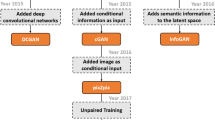Abstract
Despite the increasing use of deep learning in medical image segmentation, acquiring sufficient training data remains a challenge in the medical field. In response, data augmentation techniques have been proposed; however, the generation of diverse and realistic medical images and their corresponding masks remains a difficult task, especially when working with insufficient training sets. To address these limitations, we present an end-to-end architecture based on the Hamiltonian Variational Autoencoder (HVAE). This approach yields an improved posterior distribution approximation compared to traditional Variational Autoencoders (VAE), resulting in higher image generation quality. Our method outperforms generative adversarial architectures under data-scarce conditions, showcasing enhancements in image quality and precise tumor mask synthesis. We conduct experiments on two publicly available datasets, MICCAI’s Brain Tumor Segmentation Challenge (BRATS), and Head and Neck Tumor Segmentation Challenge (HECKTOR), demonstrating the effectiveness of our method on different medical imaging modalities.
Access this chapter
Tax calculation will be finalised at checkout
Purchases are for personal use only
Similar content being viewed by others
References
Andrearczyk, V., et al.: Overview of the HECKTOR challenge at MICCAI 2021: automatic head and neck tumor segmentation and outcome prediction in PET/CT images. In: Andrearczyk, V., Oreiller, V., Hatt, M., Depeursinge, A. (eds.) MICCAI 2021. LNCS, vol. 13209, pp. 1–37. Springer, Cham (2022). https://doi.org/10.1007/978-3-030-98253-9_1
Baid, U., et al.: The RSNA-ASNR-MICCAI brats 2021 benchmark on brain tumor segmentation and radiogenomic classification. arXiv preprint arXiv:2107.02314 (2021)
Biffi, C., et al.: Learning interpretable anatomical features through deep generative models: application to cardiac remodeling. In: Frangi, A.F., Schnabel, J.A., Davatzikos, C., Alberola-López, C., Fichtinger, G. (eds.) MICCAI 2018. LNCS, vol. 11071, pp. 464–471. Springer, Cham (2018). https://doi.org/10.1007/978-3-030-00934-2_52
Caterini, A.L., Doucet, A., Sejdinovic, D.: Hamiltonian variational auto-encoder. In: Advances in Neural Information Processing Systems, vol. 31 (2018)
Chen, Y., et al.: Generative adversarial networks in medical image augmentation: a review. Comput. Biol. Med. 144, 105382 (2022)
Gan, M., Wang, C.: Esophageal optical coherence tomography image synthesis using an adversarially learned variational autoencoder. Biomed. Opt. Express 13(3), 1188–1201 (2022)
Goodfellow, I.J., et al.: Generative adversarial networks. arXiv preprint arXiv:1406.2661 (2014)
Guibas, J.T., Virdi, T.S., Li, P.S.: Synthetic medical images from dual generative adversarial networks. arXiv preprint arXiv:1709.01872 (2017)
Huo, J., et al.: Brain lesion synthesis via progressive adversarial variational auto-encoder. In: Zhao, C., Svoboda, D., Wolterink, J.M., Escobar, M. (eds.) SASHIMI 2022. LNCS, vol. 13570, pp. 101–111. Springer, Cham (2022). https://doi.org/10.1007/978-3-031-16980-9_10
Isensee, F., Jaeger, P.F., Kohl, S.A., Petersen, J., Maier-Hein, K.H.: NNU-Net: a self-configuring method for deep learning-based biomedical image segmentation. Nat. Methods 18(2), 203–211 (2021)
Islam, J., Zhang, Y.: Gan-based synthetic brain pet image generation. Brain Inform. 7(1), 1–12 (2020)
Kebaili, A., Lapuyade-Lahorgue, J., Ruan, S.: Deep learning approaches for data augmentation in medical imaging: a review. J. Imaging 9(4), 81 (2023)
Kingma, D.P., Welling, M.: Auto-encoding variational bayes. arXiv preprint arXiv:1312.6114 (2013)
Liang, J., Chen, J.: Data augmentation of thyroid ultrasound images using generative adversarial network. In: 2021 IEEE International Ultrasonics Symposium (IUS), pp. 1–4. IEEE (2021)
Lundervold, A.S., Lundervold, A.: An overview of deep learning in medical imaging focusing on MRI. Z. Med. Phys. 29(2), 102–127 (2019)
Mao, X., Li, Q., Xie, H., Lau, R.Y., Wang, Z., Paul Smolley, S.: Least squares generative adversarial networks. In: Proceedings of the IEEE International Conference on Computer Vision, pp. 2794–2802 (2017)
Mescheder, L., Geiger, A., Nowozin, S.: Which training methods for GANs do actually converge? In: International Conference on Machine Learning, pp. 3481–3490. PMLR (2018)
Ronneberger, O., Fischer, P., Brox, T.: U-net: convolutional networks for biomedical image segmentation. In: Navab, N., Hornegger, J., Wells, W.M., Frangi, A.F. (eds.) MICCAI 2015. LNCS, vol. 9351, pp. 234–241. Springer, Cham (2015). https://doi.org/10.1007/978-3-319-24574-4_28
Sandfort, V., Yan, K., Pickhardt, P.J., Summers, R.M.: Data augmentation using generative adversarial networks (cyclegan) to improve generalizability in CT segmentation tasks. Sci. Rep. 9(1), 1–9 (2019)
Zhou, T., Vera, P., Canu, S., Ruan, S.: Missing data imputation via conditional generator and correlation learning for multimodal brain tumor segmentation. Pattern Recogn. Lett. 158, 125–132 (2022)
Zhuang, P., Schwing, A.G., Koyejo, O.: FMRI data augmentation via synthesis. In: 2019 IEEE 16th International Symposium on Biomedical Imaging (ISBI 2019), pp. 1783–1787. IEEE (2019)
Delgado, J., Oyedele, L.: Deep learning with small datasets: using autoencoders to address limited datasets in construction management. Appl. Soft Comput. 112, 107836 (2021)
Author information
Authors and Affiliations
Corresponding author
Editor information
Editors and Affiliations
Rights and permissions
Copyright information
© 2024 The Author(s), under exclusive license to Springer Nature Singapore Pte Ltd.
About this paper
Cite this paper
Kebaili, A., Lapuyade-Lahorgue, J., Vera, P., Ruan, S. (2024). End-to-End Autoencoding Architecture for the Simultaneous Generation of Medical Images and Corresponding Segmentation Masks. In: Su, R., Zhang, YD., Frangi, A.F. (eds) Proceedings of 2023 International Conference on Medical Imaging and Computer-Aided Diagnosis (MICAD 2023). MICAD 2023. Lecture Notes in Electrical Engineering, vol 1166. Springer, Singapore. https://doi.org/10.1007/978-981-97-1335-6_3
Download citation
DOI: https://doi.org/10.1007/978-981-97-1335-6_3
Published:
Publisher Name: Springer, Singapore
Print ISBN: 978-981-97-1334-9
Online ISBN: 978-981-97-1335-6
eBook Packages: Computer ScienceComputer Science (R0)




